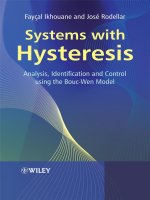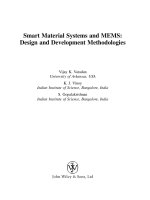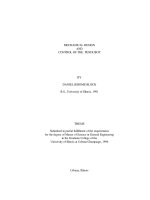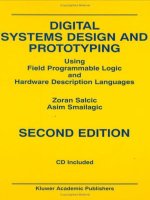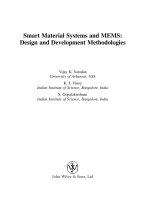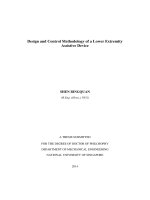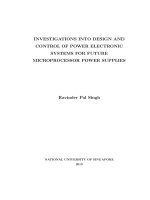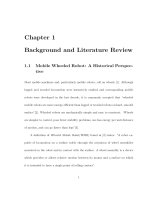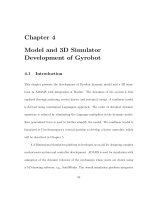laboratory design and development iot supported smart agriculture for environmental monitoring and control using esp32
Bạn đang xem bản rút gọn của tài liệu. Xem và tải ngay bản đầy đủ của tài liệu tại đây (4.12 MB, 22 trang )
<span class="text_page_counter">Trang 1</span><div class="page_container" data-page="1">
<b>HANOI NATIONAL UNIVERSITYVIETNAM JAPAN UNIVERSITY</b>
<b>SCIENCE RESEARCH TOPIC</b>
LABORATORY DESIGN AND DEVELOPMENT
IOT SUPPORTED SMART AGRICULTURE FOR ENVIRONMENTAL MONITORING AND CONTROL USING ESP32.
<i><small>Hanoi, October 2023</small></i>
<b>Instructor: Dr. Bui Huy KienImplementation team: Bui The Trung</b>
Pham Minh Tuan Pham Quang Anh Nguyen Thai Son Tran Hoang Hiep Nguyen Dang Phuc Thanh
</div><span class="text_page_counter">Trang 2</span><div class="page_container" data-page="2"><b>TABLE OF CONTENTS</b>
<b><small>CHAPTER I: INTRODUCTION TO THE RESEARCH TOPIC...1</small></b>
1.1. Urgency of the topic... 1
1.1.1. Topic name...1
1.1.2. Reason for choosing the topic...1
1.2. Research objectives... 3
1.2.1. General research objectives... 3
1.2.2. Specific research objectives...3
1.3.2. Scope of research...4
1.4. Overview of research situation...4
1.4.1. Overview of foreign research situation...4
1.4.2. Overview of domestic research situation...5
<b>CHAPTER II: THEORETICAL BASIS... 7</b>
2.1. Internet of Things (IoT) in Agriculture... 7
2.2. ESP32 - Microcontroller and Wi-Fi Module...7
2.4. IoT application in Agricultural Environmental Monitoring...8
2.5. IoT Application Development...8
2.6. Future development...8
<b><small>CHAPTER III: RESEARCH METHODS... 9</small></b>
<small>3.1. System design...9</small>
<small>3.2. Select hardware device... 10</small>
<small>3.3. Select device software... 14</small>
<small>3.3.1. Web Blynk... 14</small>
<small>3.3.2. Mobile app Blynk... 15</small>
<small>3.4. Programming system... 16</small>
<b>CHAPTER IV: RESEARCH RESULTS... 17</b>
<small>4.1. Results of experimental planting... 17</small>
<small>4.2. Scientific contributions...17</small>
<b>CHAPTER V: SOLUTIONS AND PROPOSALS... 19</b>
<small>5.1. Smart laboratory design solution...19</small>
<small>5.2. Proposal to expand and develop the system... 19</small>
<b>CHAPTER VI: REFERENCES... 20</b>
</div><span class="text_page_counter">Trang 3</span><div class="page_container" data-page="3"><b>CHAPTER I: INTRODUCTION TO THERESEARCH TOPIC</b>
<b>1.1. Urgency of the topic1.1.1. Topic name</b>
Design and Development of IoT Enabled Smart Agriculture Lab for Environmental Monitoring and Control using ESP32.
<b>1.1.2. Reason for choosing the topic</b>
Below are the reasons we decided to choose the topic: “Design and
Environmental Monitoring and Control using ESP32.” :
● IoT is a rapidly growing technology with many potential applications in agriculture. IoT devices can be used to collect data about environmental conditions, such as temperature, humidity, light levels, and soil moisture. This data can then be used to optimize crop yields and improve crop quality.
● The ESP32 is a powerful and flexible microcontroller suitable for IoT applications. The ESP32 has a built-in WiFi and Bluetooth radio, making it easy to connect to the internet and other devices. It also has a series of sensors and peripherals that can be used to collect environmental data.
● There is a growing demand for smart agriculture solutions that can help farmers improve productivity and reduce costs. IoT-enabled smart agriculture labs can provide farmers with real-time data on environmental conditions and crop health. This data can be used to
</div><span class="text_page_counter">Trang 4</span><div class="page_container" data-page="4">make informed decisions about irrigation, fertilization, and pest control.
In addition to these reasons, I'm also interested in this topic because we believe it has the potential to make a real impact in the world. Smart agriculture can help improve food security, reduce environmental impact and create new jobs. We are excited to join this growing field and contribute to the development of new IoT-enabled smart agriculture solutions.
Here are some specific benefits of using IoT in agriculture:
<b>● Increase crop yields: IoT can help farmers optimize their crop yields</b>
by providing them with real-time data on environmental conditions and crop health. This data can be used to make informed decisions about irrigation, fertilization, and pest control.
<b>● Improve crop quality: IoT can help farmers improve the quality of</b>
their crops by monitoring pests and diseases early. This can help reduce crop losses and improve the overall quality of the harvest.
<b>● Reduce costs: IoT can help farmers reduce costs by automating tasks</b>
such as irrigation and fertilization. This can help farmers save time and money, which can be reinvested in their business.
<b>● Increased sustainability: IoT can help farmers make their operations</b>
more sustainable by reducing water use and fertilizer runoff. This can help protect the environment and ensure that future generations have access to clean water and healthy soil.
I believe that developing IoT-enabled smart agriculture labs is an important step towards a more productive and sustainable food system. I'm excited to join this effort and contribute to the development of new technologies that can help farmers feed the world.
</div><span class="text_page_counter">Trang 5</span><div class="page_container" data-page="5"><b>1.2. Research objectives</b>
The research objective of the project "Design and Development of an IoT-enabled Smart Agriculture Laboratory for Environmental Monitoring and Control using ESP32" is to design and develop a smart agriculture laboratory that supports IoT for environmental monitoring and control using ESP32. This is one of the applications of IoT in smart agriculture. Smart agriculture is an agricultural system that applies digital technologies to monitor, control and care for crops automatically, helping to maximize productivity and quality of agricultural products.
ESP32 is a microcontroller designed for IoT applications and is widely used in IoT applications
<b>1.2.1. General research objectives</b>
environmental monitoring and control using ESP32.
<b>1.2.2. Specific research objectives</b>
Environmental monitoring and control using ESP32.
<b>1.3. Object and scope of research1.3.1. Research subjects</b>
The focus of the project, “Design and Development of an IoT-enabled Smart Agriculture Laboratory for Environmental Monitoring and Control using ESP32”, is a smart agriculture laboratory equipped with IoT capabilities.
This laboratory is specifically engineered to regulate its environment using the ESP32. It employs various sensors to track environmental parameters such as humidity, temperature, light intensity, and soil pH levels.
</div><span class="text_page_counter">Trang 6</span><div class="page_container" data-page="6">The ESP32 collects and processes the data from these sensors, providing users with a comprehensive view of the laboratory’s conditions. This information allows users to fine-tune these parameters, optimizing the lab’s environment for agricultural production.
<b>1.3.2. Scope of research</b>
The research scope of the project "Design and Development of an IoT-enabled Smart Agriculture Laboratory for Environmental Monitoring and Control using ESP32" is to monitor and control the environment in the laboratory using ESP32. Specifically, this topic focuses on using sensors to monitor parameters such as humidity, temperature, light and soil pH in the laboratory. Data from these sensors is collected and processed by the ESP32 to give users an overview of the laboratory environment and can adjust parameters to optimize production.
<b>1.4. Overview of research situation</b>
<b>1.4.1. Overview of foreign research situation</b>
IoT is a technology that plays an important role and is starting to impact the agricultural industry. IoT includes the underlying communications infrastructure used to connect smart objects from sensors, vehicles, mobile devices to remote data collection based on intelligent analytics, communication users and revolutionize the agricultural industry[1]. Smart agriculture is an agricultural system that applies digital technologies to monitor, control and care for crops automatically, helping to maximize productivity and quality of agricultural products[1].
.Ericsson Technology Group and RMIT University signed an agreement to establish an Artificial Intelligence Laboratory (AI RMIT-Ericsson) on August 18, 2023[1]. AI Lab collaborations will include integrated training/learning programs on 5G, artificial intelligence, machine learning, automation, cloud
</div><span class="text_page_counter">Trang 7</span><div class="page_container" data-page="7">computing, blockchain and related technologies[2]. Also through the AI Lab initiative, Ericsson and RMIT will support businesses, communities and academic partners in the industry to create and deploy AI solutions to pioneer industry 4.0 applications in many industries, including energy, manufacturing, agriculture, transportation and logistics.
LoRa module is a type of wireless module that uses LoRaWAN technology to connect IoT devices[1]. LoRaWAN is a wireless network protocol based on LoRa (Long Range) that allows data transmission over long distances at low cost and with low power consumption. The LoRa module will be used to:
• Enhance home security
• Home automation for IoT-enabled smart devices.
<b>1.4.2. Overview of domestic research situation</b>
<b>● Development of IoT in Agriculture:</b>
In recent years, the development of IoT in the agricultural sector in Vietnam has attracted interest from both the government and agricultural businesses. The goal is to improve the efficiency and quality of agricultural products, reduce resource waste and optimize farming processes.
Universities and research organizations, such as the Institute of Information Technology and Telecommunications (IOIT) have conducted many research projects related to IoT in agriculture. These projects focus on using sensors to monitor many important environmental factors such as temperature, humidity, and light.
Research in Vietnam also focuses on developing specific IoT applications in the agricultural sector, such as automatic watering monitoring and control systems and smart farm management systems.
</div><span class="text_page_counter">Trang 8</span><div class="page_container" data-page="8"><b>● Using LoRa module in research:</b>
LoRa module technology has also attracted the attention of research and businesses in Vietnam. LoRa modules enable data transmission over long distances at low cost and with low power consumption, which is very useful in agricultural IoT applications.
Research institutions and enterprises have used LoRa modules to develop custom IoT applications, such as smart farm monitoring and agricultural infrastructure management.
In Vietnam, the development of LoRaWAN network infrastructure has created favorable conditions for the implementation of IoT projects using LoRa modules. This has spurred the growth of LoRa-based IoT solutions in many sectors, including agriculture.
<b>● Projects and Initiatives:</b>
Many projects and initiatives are implemented in Vietnam to apply IoT and LoRa in agriculture. For example, the "Smart Agriculture" project in several provinces has helped improve crop productivity and manage resources more effectively.
RMIT-Ericsson AI program, provide opportunities to develop and apply IoT technology in agriculture and other sectors.
</div><span class="text_page_counter">Trang 9</span><div class="page_container" data-page="9"><b>CHAPTER II: THEORETICAL BASIS</b>
<b>2.1. Internet of Things (IoT) in Agriculture</b>
IoT refers to the ability to connect and exchange data between devices via the Internet. In agriculture, IoT plays an important role in providing real-time information about environmental conditions, such as temperature, humidity, light, and CO2 concentration. This allows farmers and researchers to get a detailed look at the environments where crops and animals grow. This helps in making smart decisions about watering, fertilizer use, and crop management. The combination of IoT with agriculture has improved efficiency and helped save precious resources.
<b>2.2. ESP32 - Microcontroller and Wi-Fi Module</b>
ESP32 is a microcontroller with Wi-Fi connectivity, suitable for IoT applications. This means that the ESP32 is capable of connecting to the Internet and transmitting data it collects from sensors. Using the ESP32 in the project helps create a reliable and efficient IoT system. This microcontroller is capable of real-time data processing and integration with environmental sensors, allowing data collection and data transmission to mobile applications or servers.
<b>2.3. Environmental Sensors</b>
Environmental sensors play an important role in collecting information about agricultural environmental conditions. Sensor types include temperature, humidity, light, pH, and CO2 concentration sensors. These sensors provide specific data about the environment, such as soil temperature, air humidity, sunlight, soil acidity, and air quality. Through the use of these sensors, the system is capable of monitoring and assessing the agricultural environment in detail and real time.
</div><span class="text_page_counter">Trang 10</span><div class="page_container" data-page="10"><b>2.4. IoT application in Agricultural Environmental Monitoring</b>
The combination of IoT with agricultural environmental monitoring allows farmers and researchers to monitor their crop and environmental conditions. Data from sensors can be used to make smart decisions about watering, fertilizer use, and harvest timing management. IoT helps improve agricultural performance by enabling more efficient use of resources and optimizing the farming process.
<b>2.5. IoT Application Development</b>
To use data from ESP32 sensors and microcontrollers, developing a mobile application or web interface is necessary. This application allows users to connect to the ESP32 device and view environmental data. It also provides remote control, allowing users to adjust the agricultural environment based on information from sensors.
<b>2.6. Future development</b>
The future of IoT in agriculture is promising with various potential applications. Using this project can help improve crop quality, optimize resources, and predict weather and agricultural conditions. Future developments may include integration with artificial intelligence (AI) and machine learning to create smart agricultural management systems.
</div><span class="text_page_counter">Trang 11</span><div class="page_container" data-page="11"><b>CHAPTER III: RESEARCH METHODS</b>
<b>3.1. System design</b><i><small>Figure 3.1. Device diagram</small></i>
<i><small>Figure 3.2. Model overview diagram</small></i>
</div><span class="text_page_counter">Trang 12</span><div class="page_container" data-page="12"><b>3.2. Select hardware device</b>
<b>Table 1: Hardware lists.1. ESP32</b>
<b>2. Module Relay</b>
<b>3. Arduino</b>
</div><span class="text_page_counter">Trang 13</span><div class="page_container" data-page="13"><b>4. Mini pump 12VDC - 60W</b>
<b>5. Module RTC</b>
<b>6. Module Light sensor</b>
</div><span class="text_page_counter">Trang 14</span><div class="page_container" data-page="14"><b>7. Module Water sensor</b>
<b>8. 16x2 inch LCD screen</b>
<b>9. OLED screen</b>
</div><span class="text_page_counter">Trang 15</span><div class="page_container" data-page="15"><b>10. Soil sensor</b>
<b>11. Beehive source</b>
<b>12. 12V LED lamp</b>
</div><span class="text_page_counter">Trang 16</span><div class="page_container" data-page="16"><b>13. Temperature and humiditysensor</b>
<b>3.3. Select device software</b>
Control software: Blynk
<b><small>3.3.1. Web Blynk</small></b>
<b>a. Software overview</b>
<small>Figure 3.3.1. Blynk web interface for humidity and…</small>
</div><span class="text_page_counter">Trang 17</span><div class="page_container" data-page="17"><b>3.3.2. Mobile app Blynk</b>
<small>Figure 3.3.2. Blynk app interface for humidity and…</small>
</div><span class="text_page_counter">Trang 18</span><div class="page_container" data-page="18"><b>3.4. Programming system</b>
<small>Refer to the code at the github link:MorpheusOQug/Lab_IOP: Nghiên cứu khoa học(github.com)</small>
</div><span class="text_page_counter">Trang 19</span><div class="page_container" data-page="19"><b>CHAPTER IV: RESEARCH RESULTS</b>
<b>4.1. Results of experimental planting</b>● Information on test plant samples:
<small>-The experiment involved planting two types of plants: Giant tomatoes,beef tomatoes, and peas. These seeds originated from the RussianFederation.</small>
<small>-The seeds typically germinate within 5 to 10 days. The optimaltemperature for their growth is between 15 and 40 degrees Celsius.-The plants are ready for harvest between 110 to 120 days after</small>
<small>planting. The plants can grow to a height of 1.5 to 2 meters.-When sowing the seeds, they should be covered with a thin layer of</small>
<small>soil. The best seasons for growing these plants are spring, autumn, andwinter.</small>
<small>-The seeds have a cleanliness level of 98%. The germination rate is high,with more than 80% to 90% of the seeds successfully sprouting.-For optimal growth, it is recommended to plant 3 seeds per square</small>
<b>4.2. Scientific contributions</b>
<b>● IoT in Agriculture: The project establishes a smart agriculture lab using</b>
IoT, paving the way for research on utilizing this technology for environmental monitoring and control in agriculture.
<b>● AgriculturalEnvironmentManagement:</b> The project aids in researching how to monitor and control agricultural environments like temperature, humidity, light, and soil quality. This can help in managing resources optimally and boosting agricultural productivity.
<b>● Energy Efficiency: The use of IoT and ESP32 for environmental</b>
monitoring can lead to energy and resource conservation in agriculture.
</div>